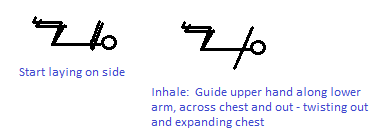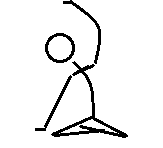This sequence is designed to remove physical tensions (particularly in the back and shoulders) and focus and relax the mind by coordinating the movements with the breath. If you have time, end with one or both of the following: alternate nostril breathing to calm and balance the body and mind, or yoga nidra to invoke deep relaxation.
This post describes:
Precautions
Some practices in this sequence are not recommended for those who:
- Have had recent abdominal surgery
- Have osteoporosis
- Are pregnant
Modifications are required if you have any of the following health conditions:
- High blood pressure, heart conditions, vertigo
- Problems with the back, knees or wrists
Take care, move with awareness and stop if you are feeling uncomfortable or any pain.
Refer to the articles linked to each practice for detailed information including benefits and contraindications.
Refer to Making the Sequence Your Own section for notes on modifying the practices for different health conditions.
If you are unsure about the suitability of a practice for your health condition, seek advice from your doctor.
The Practices
- Cat stretch (Marjariasana)
Move the spine vertebra by vertebra always starting at the tail bone and moving up. Inhale as you arch the spine down, exhale as you arch the spine up.
- Wide-legged child's pose

- Maltese cross (Modified jathati pavaritti)

The version I learnt starts with the practitioner laying on his or her side with arms out in front at shoulder level, palms facing; legs are bent so that thighs are perpendicular to the trunk and the lower legs; and the head is facing towards the hands. If needed, place a cushion or blanket under your head to ensure that your head and neck are aligned.
- Inhale and guide the upper hand up along the lower arm towards the chest, across the chest and out to the other side at shoulder level. The body twists out, the chest expands and the head follows the hand until it is looking over the opposite shoulder.
- Exhale and curl the arm back along itself, across the chest, and along the lower arm until the palms are back together. The head follows the movement of the hand and the body twists back to the starting position.
Perform 2-3 times and then lay over on your other side and repeat the twist on that side.
- Clock
Start laying on the side as described for the maltese cross.
- Inhale as you rotate at the shoulder bringing the arm up and out in a circle along the ground until the arm is out to the side at shoulder height, chest is expanded, and there is a gentle twist through the torso.
- Exhale bring the arm down and around back to the starting position.
Perform up to another two rotations and then switch sides and perform the clock on the other side.
- Sit in a cross-legged position or swastikasana variation
 Bend forward from the hips keeping the back straight. Feel the stretch in the glutes.
Bend forward from the hips keeping the back straight. Feel the stretch in the glutes.
 Sit upright and place one hand on the floor beside your buttock.
Sit upright and place one hand on the floor beside your buttock.
- Raise the other arm up overhead, keeping the shoulder relaxed in its socket.
- Bend the torso to the side bringing the opposite hand overhead.
Think about reaching up and out instead of bending over. Feel the stretch down the side of the torso.
- Repeat the side bend on the other side.
- Reverse the position of the legs and perform another forward fold and side bend to each side.
And if you have time, continue with:
- Alternate nostril breathing (nadi shodhana) from a comfortable seated position
- Yoga nidra relaxation from shavasana or a comfortable seated position
One of my favourite recordings is the SomnologiX 10-minute yoga nidra relaxation.
Making the Sequence Your Own
This section describes:
- General modifications required for specific health conditions
- Modifications for each of the practices, if available
General modifications for specific health conditions
Following are general guidelines for different health conditions:
- High blood pressure, heart conditions, vertigo
- Keep your head above or level with the heart in the cat stretch and forward folds.
Instead of raising your arm above your head in the side bend, wrap the arm behind your back (for a bonus shoulder and chest stretch) or bend the elbow and place your hand behind your head.
- Osteoporosis
- To minimise the risk of fractures, substitute alternative practices for the maltese cross, clock, forward folds, and side bends.
Perform the cat stretch from a standing or seated position to protect the spine.
- Pregnancy
- The cat stretch can be performed but after the first trimester avoid contracting the abdomen.
Substitute alternative practices for the maltese cross and clock, and after the first trimester modify or substitute an alternative practice for the forward folds.
Perform yoga nidra seated or laying on your side with lots of bolsters for support. After the first trimester avoid laying on your back to ensure that there is adequate blood flow to the uterus.
- Abdominal problems or recent surgery
- The cat stretch can be performed but avoid contracting the abdomen.
Substitute alternative practices for the maltese cross, clock and the forward folds.
Modifications for practices
Following are modifications or alternative practices for the practices in the sequence:
- Cat stretch
- If you have problems with your knees, ensure you have adequate padding to protect them.
If you have problems with your wrists, you can make fists and place the knuckles on the floor or come down onto your forearms.
Alternatively, perform the cat stretch from a semi-squatting position (a standing cat) or seated in a chair (a seated cat).
- Wide legged child's pose
- If you have high blood pressure, heart conditions or vertigo, make fists with your hands, stack one on top of the other and then rest your forehead on the fists.
If you have problems with your knees, try one of the following:
 A variation of crocodile (makarasana) laying face down, forehead resting on hands, legs wide with feet turned out to the side.
A variation of crocodile (makarasana) laying face down, forehead resting on hands, legs wide with feet turned out to the side.
 Forward fold with the legs out wide
Forward fold with the legs out wide
Bend forward from the hips and think about pushing the chest forward and elongating the back instead of bringing the chest to the ground.
The forward fold can also be performed from a chair but if you have high blood pressure, heart condition or vertigo, do not drop the head below the knees.
- Full butterfly (poorna titali)
The full butterfly can also be performed from a chair or laying supine on the floor. To perform from a chair, sit on the edge of the chair with feet flat on the floor and slightly wider than hip width apart. Bring the knees together and then out, loosening up around the hips.
If you have abdominal problems or are pregnant, the full butterfly is the most suitable alternative practice.
- Maltese cross
- If you are pregnant or have abdominal or lower back problems, substitute the maltese cross with one of the following practices:
- A shoulder opening sequence:
- Come into a comfortable seated position either on the floor or on a chair, and place hands with palms against the chest and the right hand resting on top of the left.
- Inhale and extend the right arm out at shoulder level, palm facing foward.
- Exhale and turn head to look over the left shoulder.
- Inhale and turn head back to centre.
- Exhale and bring arm back to centre and place left hand on top.
- Repeat on the other side.
View the shoulder openers with Kate Holcombe around the 7:00 minute mark to see a demonstration of this sequence.
- A chest stretch:
- Bend the elbows so that the arms are at a right angle close by your sides. Have the palms face up as if you are holding a tray.
- Keeping the angle and hand position, bring the elbows back and bring the shoulder blades together.
- Hold for a couple of breaths and then release.
- Repeat up to four more times, holding the stretch for 2-3 breaths.
From a seated position on a chair or a standing position:
- A shoulder opening sequence:
- Clock
- If you are pregnant or have abdominal or lower back problems, substitute the clock with one of the following:
- The shoulder opening sequence or chest stretch listed as alternatives for the maltese cross
- Shoulder rotations (Skandha chakra)
- Forward fold from cross-legged position
- This practice was designed to stretch the glute muscles.
If you are pregnant, seek advice from your doctor on the best stretches for your glutes.
If you have abdominal problems, recent abdominal surgery or knee problems, try the single-leg leg lock pose (supta pawanmukthasana). If you have neck problems, keep the neck on the floor with the chin drawn under slightly to ensure that the spine is straight. If you have high blood pressure or heart conditions, do not retain the breath. If you have adominal problems or recent abdominal surgery do not pull the leg tight in against the stomach.
If you are aiming to calm the nervous system, perform the forward fold with the legs out wide or from a chair as described in the wide-legged child's pose.
- Side bend from cross-legged position
 If you have problems with your knees, sit with the legs out wide or in a chair.
If you have problems with your knees, sit with the legs out wide or in a chair. If you have severe osteoporosis or lower back problems, keep one hand on the ground and raise the other arm into the sky, keeping the shoulder low in its socket. Think about reaching up instead of leaning over. If you have high blood pressure, heart conditions or vertigo, place the hand behind your head and think about reaching up with your elbow.
- Alternate nostril breathing
- Perform from a comfortable seated position either on the floor or in a chair.
If one or both nostrils are blocked, for example, if you have a cold or allergies, then visualise the practice.
- Yoga nidra
- Yoga nidra is suitable for most people. However, because yoga nidra can be deeply internalising, the practice can be unsuitable for people suffering from mental conditions such as depression. A long yoga nidra might also be unsuitable for people who suffer from epilepsy or seizures. If you are unsure whether yoga nidra is suitable for you, seek advice from your doctor before starting the practice.
Traditionally, practitioners lay in shavasana for yoga nidra but you can choose any comfortable position either sitting or laying down. If you are in the second or third trimester of your pregnancy, sit in a chair or lay on your side with bolsters to support you.

No comments:
Post a Comment
Comments for posts older than 14 days will not immediately display. These comments are reviewed before they are published for public display.